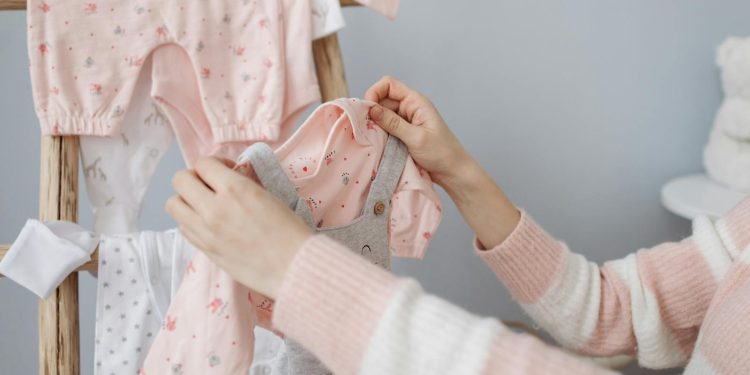Bringing a new baby into your home is an exciting time, but it also comes with the challenge of keeping everything organized. Between onesies, tiny socks, bibs, and blankets, baby clothing can easily pile up and become overwhelming. An efficiently organized baby wardrobe not only saves you time but also helps reduce stress, making the day-to-day care of your little one smoother and more enjoyable. In this guide, we’ll provide practical tips to help you organize your baby’s wardrobe efficiently and create a system that works for you and your family.
1. Categorize Clothing by Size and Season
The first step to organizing your baby’s wardrobe is to categorize clothing by size and season. Babies grow very quickly, and they can move through clothing sizes in just a matter of weeks. To avoid feeling overwhelmed, separate clothes by size—newborn, 0-3 months, 3-6 months, and so on. You can use labeled storage bins, drawers, or even dividers within the closet to keep different sizes distinct.
Also, categorize clothing by season. For instance, summer clothes should be kept separate from winter gear so you can easily grab what you need based on the weather. By keeping sizes and seasons sorted, you won’t waste time searching for suitable clothes that fit and are weather-appropriate.
2. Use Drawer Dividers for Easy Access
Baby clothes are small, and drawers can quickly become cluttered and disorganized. Drawer dividers are an excellent tool to keep everything in its place. Use dividers to separate onesies, socks, bibs, leggings, and other items. This way, each type of clothing has its own designated space, making it easy to locate items when you need them.
You can also use small baskets or containers inside the drawers to keep everything tidy. A well-organized drawer means less time spent rummaging for the right clothing item, which is especially helpful during those early days when your hands are always full.
3. Hang Frequently Used Items for Convenience
Hanging certain items in your baby’s wardrobe can make accessing them much more convenient. Items like jackets, sweaters, dresses, and outfits for special occasions are easier to see and grab when they’re hung up. Invest in child-sized hangers and consider installing a lower rod in your closet so that baby clothes are within easy reach.
You can also use closet dividers to sort hanging clothes by size or type. Hanging up frequently used items helps free up space in your drawers for smaller essentials, such as onesies and socks.
4. Utilize Storage Bins and Baskets for Bulk Items
Storage bins and baskets are lifesavers when it comes to storing baby items that you may not need on a daily basis. Use them to store extra blankets, seasonal clothes, or clothing that your baby will grow into. Clear plastic bins are particularly helpful because you can see what’s inside without having to open them.
Labeling these bins is also essential—use labels like “6-9 months,” “Winter Clothes,” or “Extra Blankets” so that everything is easy to locate. Stackable bins can help save space, and you can store them in a closet or under the crib to keep them out of sight but easily accessible.
5. Create a System for Outgrown Clothes
Since babies grow so quickly, you’ll constantly be rotating out clothes that no longer fit. Have a system in place for outgrown clothing. Keep a basket or bin in your baby’s room specifically for items they’ve outgrown. Once the bin is full, you can decide whether to store the clothes for future use, donate them, or pass them on to friends or family.
Keeping outgrown clothes separate from the rest of the wardrobe helps reduce clutter and ensures that only the clothes that fit your baby are taking up valuable space. This makes it much easier to grab what you need without sorting through clothes that are no longer usable.
6. Roll Instead of Fold
Folding baby clothes can be tricky, and traditional folding methods can lead to a cluttered and hard-to-navigate drawer. Instead, consider rolling your baby’s clothes. Rolling helps save space and makes it easier to see everything in the drawer at a glance. Onesies, leggings, and pajamas are perfect candidates for rolling.
By rolling clothes and placing them upright in the drawer, you’ll be able to quickly find exactly what you’re looking for without disturbing the rest of the clothing. This method is particularly helpful for those late-night changes when you need to find something quickly.
7. Keep Essentials Easily Accessible
There are certain items you’ll be reaching for multiple times a day, such as onesies, socks, burp cloths, and bibs. Keep these essentials easily accessible by dedicating a specific drawer or shelf to them. Organize them so that you can grab what you need without having to think twice—this is especially helpful during those chaotic moments when your baby needs a change immediately.
You could also use a small hanging organizer on the side of the crib or changing table to store these essentials within arm’s reach. The key is to minimize the time spent searching for necessary items, so you can focus more on caring for your baby.
8. Rotate Seasonal Clothing
Babies grow fast, and so do their wardrobe needs. At the start of each new season, take some time to rotate your baby’s wardrobe. Pack away clothes that are no longer suitable for the current weather, and bring out the season-appropriate items. This way, you’ll have more space and won’t have to sift through clothes that are not needed at the moment.
Storing off-season clothes in bins or on a high shelf can help you keep only what you need in your baby’s immediate wardrobe. Rotating clothing seasonally also gives you the opportunity to assess what still fits and what needs to be replaced.
9. Label Everything
Labels are a game changer when it comes to organizing a baby’s wardrobe. Whether you’re using bins, baskets, drawers, or closet dividers, labeling everything will save you time and prevent confusion. You can use a label maker or simply write on tags and stick them on the bins and shelves.
Labels make it easy for other caregivers, such as grandparents or babysitters, to find what they need without your assistance. It also helps ensure that everything is returned to its proper place, maintaining the organization you worked hard to create.
10. Make Use of Vertical Space
Maximize the storage potential of your baby’s room by making use of vertical space. Install shelves above the changing table or crib to store items that you don’t need every day, such as extra diapers, wipes, or outgrown clothing. Hanging organizers that go over the door are also useful for storing small items like shoes, hats, or accessories.
Vertical storage not only helps keep items off the floor and out of drawers, but it also keeps everything visible, making it easier to find what you need. This approach is particularly useful if you’re working with a small nursery space.













